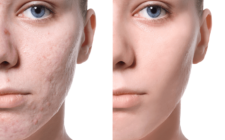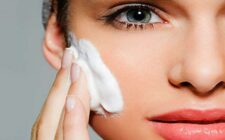Glycolic acid: what is it?
Glycolic acid (formerly called hydroxyacetic acid) is an alpha hydroxy acid (AHA) . Derived from sugar cane, beetroot or grapes, glycolic acid also responds to the name “fruit acid” alongside in particular citric acid and malic acid. It stands out among AHAs for its powerful exfoliating properties and for its reduced molecular size allowing it to penetrate the skin deeply to deliver its benefits.
Of natural or synthetic origin, glycolic acid is present in a large number of cosmetic products and aesthetic treatments . In cosmetic products, its concentration varies between 4 and 20%depending on the needs identified (pigment spots, wrinkles, complexion radiance, etc.) and will allow you to go from gentle exfoliation to more pronounced desquamation of the perfect skin.
Beyond 20% , the concentration of glycolic acid makes it possible to perform a peel . Its use is then supervised by a dermatologist and falls into the category of dermatological or aesthetic interventions. Besides the concentration of glycolic acid, the pH of the formula will influence the intensity of the exfoliation. Indeed, the higher the pH, the more the action of glycolic acid is neutralized. A good exfoliating formula will therefore contain an appropriate concentration and pH.
The benefits of glycolic acid
Formulated in a serum, a cream or in a peeling solution, glycolic acid maintains the different layers of the epidermis .
Among its benefits:
Glycolic acid is a powerful keratolytic agent . Its application to the skin triggers a non-abrasive chemical action which loosens the dead cells on the surface of the epidermis. This gentle and effective desquamation thus promotes cell renewal for the benefit of:
The appearance of the skin
Cell renewal inhibits the formation of comedones by preventing blockage of the pores that cause acne and stimulates repair of the epidermis. The acne is therefore controlled and the irregularities (scars) of the skin are reduced.
The skin renewal cycle is on average 28 days. This regular cycle allows the hypodermis, dermis and epidermis to regenerate, in other words to get “new skin”. However, with age this cycle slows down. Exfoliation with glycolic acid allows to cause controlled desquamation of the epidermis for the benefit of regular skin renewal. The skin is smoother and the appearance of fine lines and wrinkles improved.
The complexion
Hyperpigmentation and brown spots (including pregnancy mask) . Depending on the concentration of glycolic acid, the intensity of the exfoliation carried out by the acid (and therefore of the desquamation) will allow the elimination of skin cells saturated with melanin on the surface of the epidermis. This phenomenon can go as far as causing cell renewal at the level of the basal layer of the skin (deep layer of the epidermis) where the melanocytes (melanin-producing cells) are housed. The pigments present in the epidermis are therefore gradually evacuated and make it possible to attenuate or remove the brown spots visible to the naked eye.
Radiance and luminosity of the complexion. The elimination of dead cells on the surface of the epidermis rids the face of a dull veil while the stimulation of cell renewal maintains a clear and luminous complexion.
Glycolic acid works for visibly younger skin
In the context of dermatological or cosmetic procedures, the glycolic acid used can penetrate to the dermis (second constituent layer of the skin). In this context, glycolic acid can stimulate the production of:
– collagen and elastin , responsible for the firmness of the skin.
– hyaluronic acid , a natural humectant and a major player in skin hydration.
By stimulating the very foundations of the skin, glycolic acid helps maintain its firmness. Well tolerated, glycolic acid should however be used with care by a healthcare professional at this level of concentration .
For lower concentrations in cosmetics, always make sure to follow the instructions indicated on each of your products. They take into account the concentration of glycolic acid to allow you to benefit from the best results without weakening the skin. Finally, glycolic acid is photosensitizing. It is therefore strongly recommended to use it in the evening and to protect yourself from the sun afterwards.
Why use glycolic acid in a peel?
The peeling is a cosmetic procedure. From the English “to peel”, this intervention is carried out by a dermatologist and consists in causing the desquamation of the epidermis of the face to stimulate cell renewal: literally “to make a new skin”. The visible results have a direct impact on the quality of the skin, its texture and its complexion. By extension, we speak of a “peeling effect” for certain exfoliating cosmetics.
The principle of peeling is to create a “controlled burn”Using a chemical exfoliant such as glycolic acid to remove a surface layer of the skin and thus stimulate cell renewal. At the discretion of the dermatologist and depending on the condition of the skin, the peel will vary in intensity. The following may vary: the concentration of glycolic acid, the exposure time and the number of sessions prescribed. A distinction is made here between light and medium peels performed by the dermatologist on a regular basis, and deep peels performed by a cosmetic surgeon, under general anesthesia and cardiac monitoring. Performed in the event of severe skin damage, the deep peel is an exceptional and rare operation.




